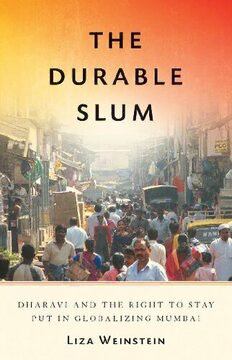
The Durable Slum: Dharavi and the Right to Stay Put in Globalizing Mumbai PDF
Preview The Durable Slum: Dharavi and the Right to Stay Put in Globalizing Mumbai
The Durable Slum Globalization and Community Susan E. Clarke, Series Editor Dennis R. Judd, Founding Editor 23 The Durable Slum: Dharavi and the Right to Stay Put in Globalizing Mumbai Liza Weinstein 22 The Fragmented Politics of Urban Preservation: Beijing, Chicago, and Paris Yue Zhang 21 Turkish Berlin: Integration Policy and Urban Space Annika Marlen Hinze 20 Struggling Giants: City-R egion Governance in London, New York, Paris, and Tokyo Paul Kantor, Christian Lefèvre, Asato Saito, H. V. Savitch, and Andy Thornley 19 Does Local Government Matter? How Urban Policies Shape Civic Engagement Elaine B. Sharp 18 Justice and the American Metropolis Clarissa Rile Hayward and Todd Swanstrom, Editors 17 Mobile Urbanism: Cities and Policymaking in the Global Age Eugene McCann and Kevin Ward, Editors 16 Seeking Spatial Justice Edward W. Soja 15 Shanghai Rising: State Power and Local Transformations in a Global Megacity Xiangming Chen, Editor 14 A World of Gangs: Armed Young Men and Gangsta Culture John M. Hagedorn 13 El Paso: Local Frontiers at a Global Crossroads Victor M. Ortíz-G onzález (continued on page 217) The Durable Slum Dharavi anD the right to Stay Put in globalizing MuMbai Liza Weinstein Globalization and Community, Volume 23 University of Minnesota Press Minneapolis London Portions of this book were previously published in Liza Weinstein and Xuefei Ren, “The Changing Right to the City: Urban Renewal and Housing Rights in Globalizing Shanghai and Mumbai,” City and Community, Symposium on India and China 8 (2009): 407–3 2; copyright 2009 John Wiley and Sons; and in Liza Weinstein, “Mumbai’s Development Mafias: Organized Crime, Land Develop- ment, and Globalization,” International Journal of Urban and Regional Research 32 (2008): 22– 39; copyright 2008 John Wiley and Sons. Portions of chapter 4 were published in Liza Weinstein, “‘One-M an Handled’: Fragmented Power and Political Entrepreneurship in Globalizing Mumbai,” International Journal of Urban and Regional Research, special issue on the Contested Indian City (forth- coming); copyright 2014 John Wiley and Sons. Portions of chapter 5 were pub- lished in LizaWeinstein, “Democracy in the Globalizing Indian City: Engagements of Political Society and the State in Globalizing Mumbai,” Politics and Society 37 (2009): 397–4 27; copyright 2009 SAGE Publications, Ltd./SAGE Publications, Inc.; all rights reserved. Copyright 2014 by the Regents of the University of Minnesota All rights reserved. No part of this publication may be reproduced, stored in a retrieval system, or transmitted, in any form or by any means, electronic, mechan- ical, photocopying, recording, or otherwise, without the prior written permission of the publisher. Published by the University of Minnesota Press 111 Third Avenue South, Suite 290 Minneapolis, MN 55401–2 520 http://www.upress.umn.edu Library of Congress Cataloging-in-Publication Data Weinstein, Liza. The durable slum : Dharavi and the right to stay put in globalizing Mumbai / Liza Weinstein. (Globalization and community ; volume 23) Includes bibliographical references and index. ISBN 978-0-8166-8309-3 (hardback) — ISBN 978-0-8166-8310-9 (pb) 1. Dharavi (Mumbai, India)—Social conditions. 2. Dharavi (Mumbai, India)— Economic conditions. 3. Slums—India—Mumbai. I. Title. HN690.D454W45 2014 307.3'3640954792—dc23 2014001741 Printed in the United States of America on acid-f ree paper The University of Minnesota is an equal-o pportunity educator and employer. 20 19 18 17 16 15 14 10 9 8 7 6 5 4 3 2 1 For my mother This page intentionally left blank ConTenTS Preface ix Abbreviations xv Introduction 1 1 Becoming Asia’s Largest Slum 25 2 State Interventions and Fragmented Sovereignties 55 3 From Labor to Land: An Emerging Political Economy 85 4 Political Entrepreneurship and Enduring Fragmentations 115 5 The Right to Stay Put 141 Conclusion: Precarious Stability 167 Acknowledgments 177 Notes 181 Bibliography 195 Index 211 This page intentionally left blank PrefaCe I came to Mumbai expecting to document a great transformation, but I ended up writing about the contentious politics of stability.1 When I began conducting the research that became this book, almost a decade ago, I was basically convinced of the overwhelming power of global capital— and the neoliberal policies that direct it— to destroy communi- ties and oversee mass displacements. With markets having largely recov- ered from the Asian financial crisis of the late 1990s, global investors were clamoring for the next big opportunity and looking for the newest emerging markets. The Indian government seemed eager to give them a map. In early 2005, as I was preparing for fieldwork in Mumbai, India was further relaxing its restrictions on foreign direct investment (FDI) in property development. Two of the slowest sectors of the Indian economy to liberalize, the real estate and construction industries, were tenuously opened first to nonresident Indians (NRIs) and persons of Indian ori- gin (PIOs) before they were thrown open to global developers and real estate investors at large. Residuals of a nationalist spirit of self- rule, or swadeshi, the globalization of property and land— literally, of Indian soil— seemed, for many, to veer too closely back to colonialism. But the nationalist dams could hold back what was certain to be a flood of global capital for only so long: in March 2005 India’s Ministry of Com- merce and Industry took steps to allow non- NRI foreign investors access to India’s increasingly lucrative real estate markets, particularly in the country’s newly created Special Economic Zones. Maharashtra’s govern- ment—ruled by an outwardly looking Congress- led coalition bent on (in their words) “transforming Mumbai into Shanghai”—was eager to capture its share of the spoils.2 ix
